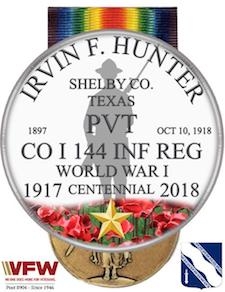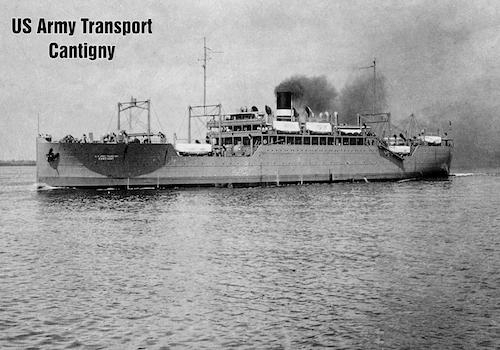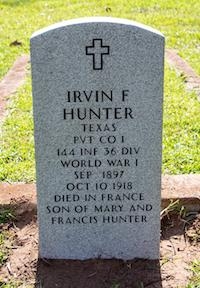 Private Irvin F. Hunter
Private Irvin F. Hunter
United States Army, World War I – Died in France, 1918
Company I, 144 Infantry Regiment – 36 Infantry Division
 May 23, 2022 - Irvin Hunter was born September 1897 in Center, Shelby County, Texas. Center is located in far East Texas and serves as the county seat of Shelby. His parents Mary Tommie Larkin of Alabama and Frank Edward Hunter of Maryland were married October 26, 1881 in Grayson County, Texas by Reverend D. Jones. Irvin had five older siblings, Clarence, Mable, Irene, Susie and Pearl. Following him in birth were brothers Bryan and Ercelle. His parents operated a boarding house in Center where they no doubt all resided and each of the children would have had assigned chores. Mother Mary sadly passed in 1911 at the age of 41 when Irvin was only 14 and was buried in the Fairview Cemetery, Center. Two years later sister Irene married Edward Slade and moved to the Dallas-Fort Worth area and Irvin also moved there possibly living with his sister.(1)(2)
May 23, 2022 - Irvin Hunter was born September 1897 in Center, Shelby County, Texas. Center is located in far East Texas and serves as the county seat of Shelby. His parents Mary Tommie Larkin of Alabama and Frank Edward Hunter of Maryland were married October 26, 1881 in Grayson County, Texas by Reverend D. Jones. Irvin had five older siblings, Clarence, Mable, Irene, Susie and Pearl. Following him in birth were brothers Bryan and Ercelle. His parents operated a boarding house in Center where they no doubt all resided and each of the children would have had assigned chores. Mother Mary sadly passed in 1911 at the age of 41 when Irvin was only 14 and was buried in the Fairview Cemetery, Center. Two years later sister Irene married Edward Slade and moved to the Dallas-Fort Worth area and Irvin also moved there possibly living with his sister.(1)(2)
With the United States declaring war on Germany April 6, 1917, nearly three years after the World War began in Europe, a national army through conscription was needed. The Selective Service Act of 1917 required Irvin to register on June 5, 1918 having attained the age of 21. Instead of registering he decided to join the Army National Guard and did so at Camp Bowie, Fort Worth, Texas on May 29, 1918. The 36 Infantry Division had been organized there the year before and was composed of National Guard troops from Texas and Oklahoma. After initial training Private Hunter, serial # 1483969 was assigned to Company I, 144 Infantry Regiment, 72 Infantry Brigade of the 36 Division.(3)
The first units of the 36 Division arrived in France, May 1918. Irvin and the 144 Infantry departed the port of Hoboken, New Jersey on July 18, 1918 aboard the transport USS George Washington. He listed his sister, Irene Slade, 3004 Travis Avenue, Fort Worth, Texas as his next of kin. There were a total of 5,524 passengers aboard, most of which were officers and enlisted soldiers.(4)
Immediately upon arrival that took approximately eleven days via Liverpool, England, the units of the division were sent to the 13th Training Area in the vicinity of the Commune of Bar-sur-Aube where the division headquarters was established. On September 26 the division moved by train and established headquarters at the Commune of Pocancy, Department of the Marne. To the north, only a short distance, the Meuse-Argonne Offensive was underway and the 36 Division joined the Fourth French Army in preparation for battle. If the carnage of war wasn’t enough, the 1918 flu pandemic was attacking worldwide killing hundreds of thousands of people. The military in Europe were not immune and half of those who fell in France was due to the influenza virus. Private Irvin F. Hunter died of pneumonia on October 10, 1918 at the age of 21. It is not known if he was still with his unit or in a hospital. That same day he was buried in temporary grave # 30, Plot B, Row 14, Suresnes American Cemetery. Irvin’s World War I Record, (Form # 724-S, A.G.O.) shows that his sister Irene of Fort Worth was the first to be notified of his death. His comrades of the 36 Division would fight on until the Armistice, November 11 suffering 2,528 casualties. They remained in France until April 26, 1919 when the first elements started for a port of embarkation to return to the United States.(5)
Following the Great War, now known as World War I, America faced a problem it had never encountered before; thousands of her citizens both male and female were buried on foreign soil. In October 1919, families were given the choice of leaving their loved ones buried in an American Cemetery in Europe with their comrades or bring them home for reburial in a State/National Cemetery or a cemetery of their choosing. Father Frank chose to bring his son back home to Shelby County, Texas. With this decision in hand the Graves Registration Service of the Army Quartermaster Corps began the process that was not an immediate one given the huge number of 46,000 remains. It also did not help that the French took until late 1920 to finally lift their band on the return of bodies. The cost to recover the dead would reach $30 million or $400 million in today’s dollars.(6)

On February 3, 1922 the remains of Irvin Hunter were disinterred and prepared for shipment to Mr. F. E. Hunter, Center, Texas. His boxed casket departed Antwerp, Belgium April 8 aboard the USS Cantigny with 211 other fallen soldiers arriving at the port of Hoboken, New Jersey, April 21. The Standard Union Newspaper, Brooklyn, New York reported that a memorial service with full military honors was held four days later at the Brooklyn Army Base. Then the last leg of the journey began on May 6 when his remains with military escort departed Hoboken by train arriving in Center the afternoon of Thursday, May 11.(7)
His father signed for the precious cargo and according to the Champion Newspaper, Center, Texas, May 17, 1922, the remains were then carried to the First Baptist Church where they were held until funeral service time. The religious services were conducted by Rev. Olive and the Norman G. Crocker Post of the American Legion had full charge of the arrangements; a military funeral being accorded the deceased [at Fairview Cemetery, Center, Texas]. In addition to his aged father, two brothers, Clarence and Bryan Hunter, and sisters, Mesdames Utley and Slade were there to attend the services. A very large number of citizens attended the services and a large floral offering was made. Day is done, God is nigh.
 Epilogue: Since my initial research about Irvin in 2017, there was always one haunting mystery—where is the headstone marking the grave? In September 2021, the family too began to wonder and contacted me through VFW Post 8904 Facebook page about the possibility of having a VA headstone ordered and installed. Working with great nieces Nancy Griffin, Emmy Henson, Patti Racicot and Rebecca Small, I initiated the paperwork and coordinated with Watson and Sons Funeral Home to receive the stone. Our request was initially denied as there was no proof that he was actually buried there. Finding further proof was difficult so as a last resort the family contacted the case worker Zachary at the Veterans Administration who reviewed the documentation more thoroughly and determined the request should be approved. It was, and the headstone was received at Watson on May 5, 2022. The family traveled to Center on Friday May 13, and with the help of Roger Doyle and Jimmy Scott it was installed in the Hunter plot 100 years after Irvin was buried in 1922.
Epilogue: Since my initial research about Irvin in 2017, there was always one haunting mystery—where is the headstone marking the grave? In September 2021, the family too began to wonder and contacted me through VFW Post 8904 Facebook page about the possibility of having a VA headstone ordered and installed. Working with great nieces Nancy Griffin, Emmy Henson, Patti Racicot and Rebecca Small, I initiated the paperwork and coordinated with Watson and Sons Funeral Home to receive the stone. Our request was initially denied as there was no proof that he was actually buried there. Finding further proof was difficult so as a last resort the family contacted the case worker Zachary at the Veterans Administration who reviewed the documentation more thoroughly and determined the request should be approved. It was, and the headstone was received at Watson on May 5, 2022. The family traveled to Center on Friday May 13, and with the help of Roger Doyle and Jimmy Scott it was installed in the Hunter plot 100 years after Irvin was buried in 1922.
Sources:
(1): Year: 1900; Census Place: Justice Precinct 1, Shelby, Texas; Roll: 1669; Page: 12; Enumeration District: 0084; FHL microfilm: 1241669
(2): Year: 1910; Census Place: Justice Precinct 1, Shelby, Texas; Roll: T624_1588; Page: 1A; Enumeration District: 0145; FHL microfilm: 1375601
(3): "Texas, World War I Records, 1917-1920," database with images, FamilySearch (https://familysearch.org/ark:/61903/3:1:3QS7-89MN-8S8M?cc=2202707&wc=334P-N38%3A1561331302%2C1561333001 : 26 March 2015), Army enlisted, dead > Gann, Richard Lee-Moeller, Otto Fridrich, 1917-1920 > image 1320 of 3256; Texas Military Forces Museum, Austin.
(4): The National Archives at College Park; College Park, Maryland; Record Group Title: Records of the Office of the Quartermaster General, 1774-1985; Record Group Number: 92; Roll or Box Number: 443
(5): Brief Histories of Divisions, US Army 1917-1918. Historical Branch, War Plans Division, General Staff, June 1921
(6): https://www.historynet.com/rest-in-peace-bringing-home-u-s-war-dead.htm
(7): Records of the Office of the Quartermaster General, 1774 – 1985. Card Register of Burials of Deceased American Soldiers, 1917 - 1922









